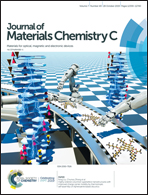Interface-engineered reliable HfO2-based RRAM for synaptic simulation†
Abstract
Future synaptic simulation using resistance random access memory (RRAM) requires higher reliability and lower power consumption of the devices and understanding of the correlation of the materials with their multi-level resistance switching (RS) properties. Using O3 pretreatment on a TiN electrode, this work highlights the significant role of the interface in the enhancement of the reliability and the power consumption of HfO2-based RRAM devices. X-ray photoelectron spectroscopy investigations indicate increases of the TiON and TiO2 components with the augmentation of the number of O3 treatment cycles, which strongly impacts the RS properties of the Pt/HfO2/TiN devices. Optimal RS properties were obtained for 20 O3 pulse-pretreated devices, which were used to emulate biological synapses after an annealing process. Analog memory properties, including analog set and reset in DC mode and potentiation/depression based on two types of designed pulses, have been achieved. Finally, one of the biological synapse learning rules, spike-timing-dependent plasticity, was successfully emulated. These results, avoiding the conventional route based on dual-layer insulators, are of significance for synaptic simulation using interface-engineered single-layer HfO2 RRAM and further reveal the internal mechanism of HfO2-based electron synapses.



 Please wait while we load your content...
Please wait while we load your content...